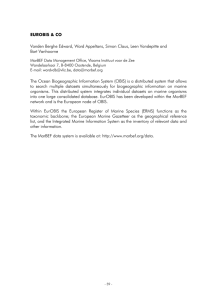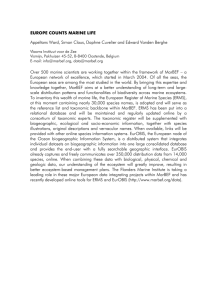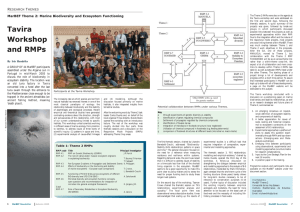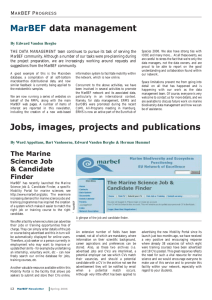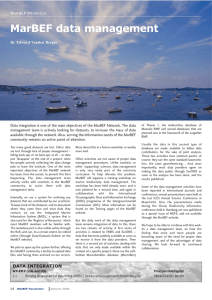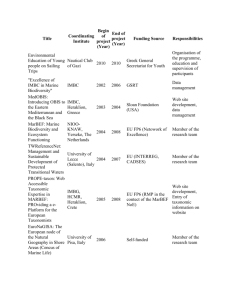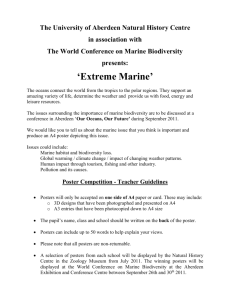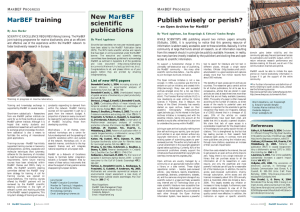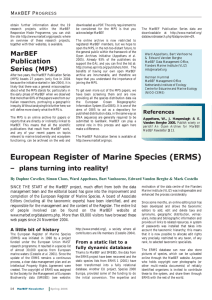Progress with Theme I data analysis activities Research Themes
advertisement
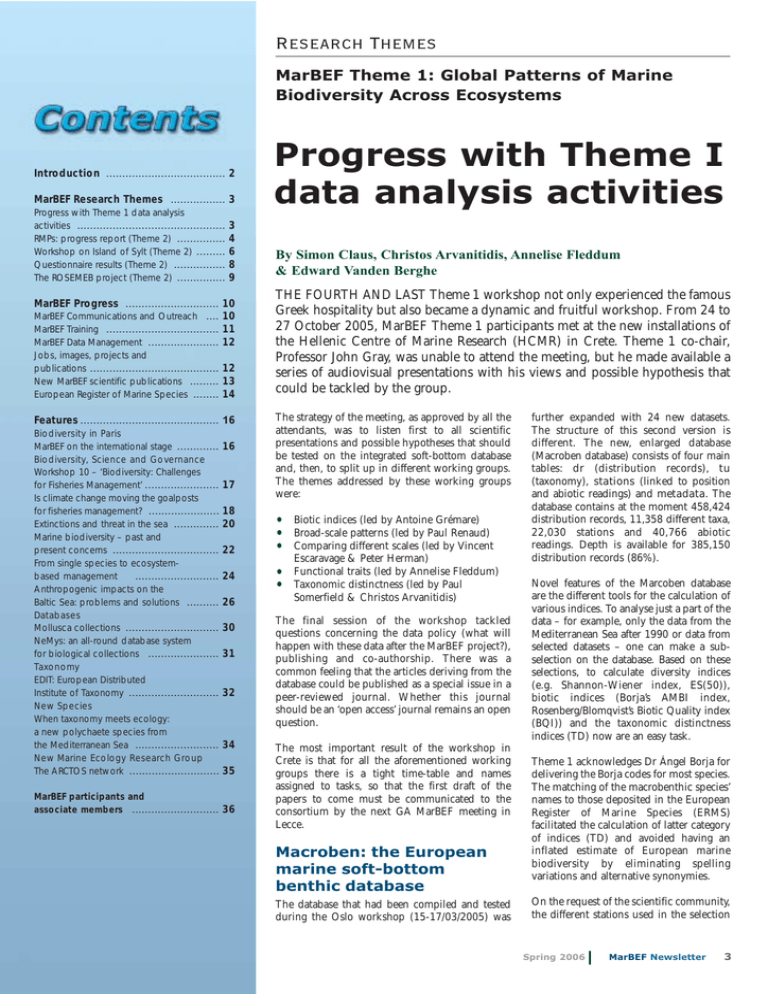
Research Themes MarBEF Theme 1: Global Patterns of Marine Biodiversity Across Ecosystems Introduction ..................................... 2 MarBEF Research Themes ................. 3 Progress with Theme 1 data analysis activities .............................................. RMPs: progress report (Theme 2) ............... Workshop on Island of Sylt (Theme 2) ......... Questionnaire results (Theme 2) ................ The ROSEMEB project (Theme 2) ............... MarBEF Progress ............................. MarBEF Communications and Outreach .... MarBEF Training ................................... MarBEF Data Management ...................... 3 4 6 8 9 10 10 11 12 Jobs, images, projects and publications ........................................ 12 New MarBEF scientific publications ......... 13 European Register of Marine Species ........ 14 Features ........................................... 16 Biodiversity in Paris MarBEF on the international stage ............. 16 Biodiversity, Science and Governance Workshop 10 – ‘Biodiversity: Challenges for Fisheries Management’ ....................... 17 Is climate change moving the goalposts for fisheries management? ...................... 18 Extinctions and threat in the sea .............. 20 Marine biodiversity – past and present concerns ................................. 22 From single species to ecosystembased management .......................... 24 Anthropogenic impacts on the Baltic Sea: problems and solutions .......... 26 Databases Mollusca collections ............................. 30 NeMys: an all-round database system for biological collections ...................... 31 Taxonomy EDIT: European Distributed Institute of Taxonomy ............................ 32 New Species When taxonomy meets ecology: a new polychaete species from the Mediterranean Sea .......................... 34 New Marine Ecology Research Group The ARCTOS network ............................ 35 MarBEF participants and associate members ........................... 36 Progress with Theme I data analysis activities By Simon Claus, Christos Arvanitidis, Annelise Fleddum & Edward Vanden Berghe THE FOURTH AND LAST Theme 1 workshop not only experienced the famous Greek hospitality but also became a dynamic and fruitful workshop. From 24 to 27 October 2005, MarBEF Theme 1 participants met at the new installations of the Hellenic Centre of Marine Research (HCMR) in Crete. Theme 1 co-chair, Professor John Gray, was unable to attend the meeting, but he made available a series of audiovisual presentations with his views and possible hypothesis that could be tackled by the group. The strategy of the meeting, as approved by all the attendants, was to listen first to all scientific presentations and possible hypotheses that should be tested on the integrated soft-bottom database and, then, to split up in different working groups. The themes addressed by these working groups were: • • • • • Biotic indices (led by Antoine Grémare) Broad-scale patterns (led by Paul Renaud) Comparing different scales (led by Vincent Escaravage & Peter Herman) Functional traits (led by Annelise Fleddum) Taxonomic distinctness (led by Paul Somerfield & Christos Arvanitidis) The final session of the workshop tackled questions concerning the data policy (what will happen with these data after the MarBEF project?), publishing and co-authorship. There was a common feeling that the articles deriving from the database could be published as a special issue in a peer-reviewed journal. Whether this journal should be an ‘open access’ journal remains an open question. The most important result of the workshop in Crete is that for all the aforementioned working groups there is a tight time-table and names assigned to tasks, so that the first draft of the papers to come must be communicated to the consortium by the next GA MarBEF meeting in Lecce. Macroben: the European marine soft-bottom benthic database The database that had been compiled and tested during the Oslo workshop (15-17/03/2005) was further expanded with 24 new datasets. The structure of this second version is different. The new, enlarged database (Macroben database) consists of four main tables: dr (distribution records), tu (taxonomy), stations (linked to position and abiotic readings) and metadata. The database contains at the moment 458,424 distribution records, 11,358 different taxa, 22,030 stations and 40,766 abiotic readings. Depth is available for 385,150 distribution records (86%). Novel features of the Marcoben database are the different tools for the calculation of various indices. To analyse just a part of the data – for example, only the data from the Mediterranean Sea after 1990 or data from selected datasets – one can make a subselection on the database. Based on these selections, to calculate diversity indices (e.g. Shannon-Wiener index, ES(50)), biotic indices (Borja’s AMBI index, Rosenberg/Blomqvist’s Biotic Quality index (BQI)) and the taxonomic distinctness indices (TD) now are an easy task. Theme 1 acknowledges Dr Ángel Borja for delivering the Borja codes for most species. The matching of the macrobenthic species’ names to those deposited in the European Register of Marine Species (ERMS) facilitated the calculation of latter category of indices (TD) and avoided having an inflated estimate of European marine biodiversity by eliminating spelling variations and alternative synonymies. On the request of the scientific community, the different stations used in the selection Spring 2006 MarBEF Newsletter 3 projection. In this way the different stations (and distribution records) can be grouped, depending on the defined grid dimensions. This tool will possibly be expanded and more automated in the future. ' Ecoserve Finally, when all selections and analysis are done, the Macroben database will allow exportation of the data matrix to a ‘common known’ matrix file, which can then be imported into statistical analysis software, such as Twinspan, PRIMER, ADE-4 and R-Package. Marine soft-bottom habitat. can also be projected (metres instead of decimal degrees) using the Lambert Azimuthal Equal Area or the Azimuthal Equidistant The final version of the database, which can be downloaded from the MarBEF website by all Theme 1 members and data providers, was distributed to all the interested parties on 25 November 2005. Additionally, an extensive manual to accompany the database was also provided. For any comments on the database structure, functionality or content, please get in touch through data@marbef.org. The MarBEF data management team (VLIZ) will keep this database up to date. Simon Claus MarBEF Theme 1 Coordination office manager BENCORE Vlaams Instituut voor de Zee Belgium Email: simon.claus@vliz.be Research Themes MarBEF Theme 2: Marine Biodiversity and Ecosystem Functioning RMPs: progress report By Rebecca Aspden & Iris Hendricks THE RESPONSIVE MODE PROJECTS of MarBEF (Phase 2) began in 2005 with sessions to discuss and develop the RMPs included in the organisation of Milestone 4-SCP-3.1, a workshop entitled “Ecosystem Stability vs Marine Biodiversity: Assessing the Evidence.” This workshop was held in Tavira, Portugal, and was planned so that participants could combine the workshop with the GA meeting in Porto in March 2005 (see report in Autumn 2005 edition of the MarBEF newsletter). The RMP phase is now well and truly under way, Table 1: Theme 2 consists of seven RMPs (Table 1), previously introduced in the Autumn 2005 MarBEF newsletter. The overall aims of these RMPs are to determine rates of ecosystem functionality in both benthic and pelagic systems, by generating theories, models and experimental tests of the relationship between marine biodiversity and ecosystem function. All seven of the Theme 2 RMPs have hosted their kick-off meetings, and plans have been made to begin experimental tests in each of the key areas. Details of the meetings and any downloads regarding these RMPs can be obtained from the individual RMP websites (Table 1), and minutes of the kick-off workshops are placed as deliverables in the download section of the MarBEF webpage (www.marbef.org). BIOFUSE has held two meetings, beginning with a workshop in Dublin, Ireland, in July 2005. The second workshop was held in Viana, Portugal, in January 2006. During the Viana workshop, experimental designs and protocols were finalised in order to address “quantifying stability at sites of naturally differing diversity and exposure to disturbance.” THEME 2 RMPs (RESPONSIVE MODE PROJECTS) RMP code Title Principal Investigator(s) RMP 4-1 RMP on Genetic Biodiversity (GBIRM) (website under construction) J.-P. Ferral RMP 4-2 The role of native and/or invasive ecosystem engineers in explaining biodiversity T. Bouma, P. Herman,T.Ysebaert RMP 4-3 Pan-European gradients in propagation and settlement events K. Philippart RMP 4-4 Effects of BIOdiversity on the FUnctioning and Stability of marine Ecosystems – European-scale comparisons (BIOFUSE) (http://www.marbef.org/projects/biofuse/index.php) T. Crowe, L. Benedetti-Cecchi RMP 4-5 Functioning of FOOD Webs across ecosystems of different BIOdiversity level (FOODWEBIO) (http://www.marbef.org/projects/foodwebio/index.php) A. Sokolowski Microbial diversity and ecosystem functions: concepts, open questions and recommendations for integration of microbes into general ecological frameworks K. Jürgens, J.M. Gasol Role of Secondary Metabolites in Ecosystem Biodiversity (ROSEMEB) (http://www.marbef.org/projects/rosemeb/index.php) A. Ianora RMP 4-6 RMP 4-7 4 and Theme 2 members have taken the first steps towards addressing the key issues of this research area. MarBEF Newsletter Spring 2006
